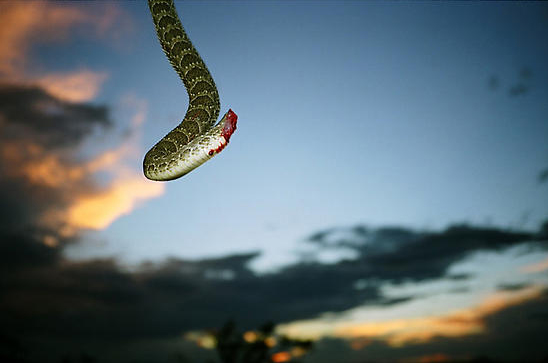American Dreams

From the Making of The Ride, 2009. All images courtesy of Renwick Gallery
Meredith Danluck is an all-around American artist, who in her career has addressed the vicissitudes of fan culture from the niche fervor around geodesic architecture to the more mainstream madness of pop-star idolatry. In 2007 Danluck, backed by her dealer Leslie Fritz, paid $3,500 dollars for a thirty-second photo-op with Michael Jackson in Japan. The resulting 12-minute short, “Michael Jackson, Jesus Christ… Coca-Cola,” opens with pandemonium. Handicapped children are loaded one by one (they did not have to pay) to meet the crestfallen star like the blind making a pilgrimage to Christ. The video goes on to capture the elaborate makeup process a Jackson impersonator endures in order to transform himself in the King of Pop. In full regalia the impersonator exploits the brand power of Jackson himself, and earns a living doing it (something the real King is less able to do of late).
Among her diverse, mixed media projects Danluck has also created a short music video for The Roots, in which one member of the ensemble taps, in rhythm, on everything the camera passes. Danluck is also considering developing further a video about the working conditions of coal miners in West Virginia, a film for which it was more difficult to find funding. Her latest project, a feature-length film about Professional Bull Riding (PBR) is a social documentary with a dusty, sun-parched palette. It screens at MoMA this month, and coincides with a new series of photographs on display as part of her latest exhibition “Drinkability,” which opens Friday at the Renwick Gallery. In one, a skeleton drives a vintage car; in another, a rattlesnake drops into the foreground, writhing against a sunset backdrop moments after its head was chopped off. Danluck has trained her eye to make the sometimes sensational exude preternatural ease.
SP: You have managed a career of making art about the American myth, its curiosities and conundrums, with conscientious aplomb, but would you say that your interests as an artist are local or global?
MD: Well, the American myth itself transcends geographical boundaries and any microcosm has its analogous macrocosm. In a nutshell I’m deeply invested in American ideas, from celebrity to American idealism, but I don’t think of them as being limited to American understanding.
SP: I guess the question could also be focused to ask: Do you consider a non-American audience when you make your work that is about myth and celebrity?
MD: I actually don’t consider any particular audience.
SP: Surely with the forthcoming feature film you’ve had envisioned an audience on some level? (LEFT: JOBY AS COMPLETE MICHAEL (PRODUCTION STILL), 2007)
MD: This project has been slightly different. Yes, I’ve had to consider certain elements, like, “Can you understand it, etc.?” In this project we use confusion as a conceptual device, which is specifically about the audience.
SP: How did the documentary on the Professional Bull Riding come about?
MD: I went to a PBR event in Nashville and was blown away. The idea of the cowboy as a mythical character in the American psyche is so strong, it was just such good subject matter-but beyond that, it was so different than what I had expected from it. I went and all of a sudden there were pyrotechnics and million-dollar checks being given out. It was as if the old America had collided with a new America and spat out this Western spectacle.
SP: Is it true that the PBR is the fast growing professional sport in America?
MD: Yes.
FROM THE MAKING OF THE RIDE, 2009
SP: Does the film have a narrative arc in the conventional sense? Was that important at the outset?
MD: The whole film has a very experimental structure, but not experimental in the kooky arty Kenneth Anger way. It’s about messing with Hollywood narrative conventions: narration, “dream sequence,” the “third act.” The whole film is analogous to the most popular American film ever made, The Wizard of Oz.
SP: There is a sort of indescribable discomfort in much of your best work that confronts American life. In your travels through America, what was the most disturbing experience you came across?
MD: The most disturbing thing I saw in the south was in West Virginia while working on my short film Wars and Rumours of Wars. One of the guys had just gotten back from Iraq and pulled out some photos of the people he had killed and began describing how he had killed them. The photos, though pretty brutal, were not as disturbing as his total flippancy towards life and death. It wasn’t the photos or even his language that bothered me, but more realizing how fragile our own perspectives are, that a normal kid can go to war and come back with a fraction of the sensitivity he once had. That was disturbing.
Meredith Danluck, “Drinkability,” is on view May 29—July 31. Renwick Gallery is located at 45 Renwick St., New York.






